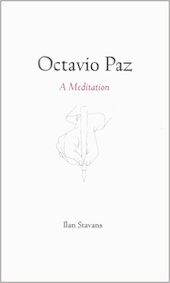|
 Book Review
by C.M. Mayo Book Review
by C.M. Mayo


OCTAVIO
PAZ: A MEDITATION
by Ilan Stavans
University of Arizona
Press, 2003
Review originally published in The Hyde Park Review of Books,
2002
Poet, essayist, critic, translator,
and editor, Octavio Paz
was, writes Stavans, "the quintessential surveyor, a Dante's
Virgil, a Renaissance man [p.3]... and a believer in reason and
dreams and poetic invention as our only salvation. [p.4]"
Born in 1914 in Mexico City, Paz lived past the age of eighty,
having written over forty books of poetry and essays, among the
latter, the classic Labyrinth of Solitude, in which, writes
Stavans, "he articulated, in lucid, erudite, nonacademic
prose, and with Olympian authority, the key to the question he
nurtured in his heart for years: What does it mean to be a Mexican
in today's world?" [p.30]
Stavans' small book is not hagiography;
rather, a series of personal reflections and explorations on
Paz's influence both on the Mexican cultural scene and on Stavans'
own development as writer and editor. Stavans, who was also born
in Mexico City, is the author of books spanning genres as diverse
as fiction, cultural criticism, and personal memoir; he is also
a translator, a professor, and the founding editor of Hopscotch:
A Cultural Review. In other words, this is a meditation on
an intellectual by an intellectual, who is by Stavans' spot-on
definition, "[an] enlightened mind capable of exploring
the nature and place of ideas," with "[no] duty to
any power other than themselves." [p.9]
Since first encountering Paz's
work, Stavans has been a "devotee and an incessant reader,"
[p.4] especially of Paz's prose, which he lauds as a "metronome
for our times," "terse, effulgent, never short of enthralling."
[p.7] Paz's poetry, however, Stavans dismisses as "too loose,
too mystical for my taste."[p.5] No matter, the question
that engrosses both Paz and Stavans is the authenticity of the
Americas, and the duality of its heritage— pre-Columbian
and European, so violently clashed yet never entirely melded.
Stavans considers Paz's adolescence,
his student years when he "would fervently discuss politics
in the streets, loved Dostoyevsky, and joined a student strike
in 1929" [p.13] ; his service in the Yucatán as a
school teacher, his adventures in Paris and the Spanish Civil
War— in short, the chronology of Paz's escape from the intellectually
suffocating bosom of then-provincial Mexico City.
A pattern was set for his life— as it was set for Stavans'
when he, too, left Mexico City— of openness and cosmopolitanism.
Paz, all his life, struggled against the rigidities of provincialism
and ideology.
Spiraling like a labyrinth itself,
Stavans' meditation then curves back to Paz's poetry. He explains
Paz's view that poetry, "although elitist and apparently
unimportant when it comes to historical and scientific progress,
is the only true habitation of the human soul— that one
can measure the sensibility of an epoch through its most mature
verses even if they are unread by the masses." [pp.27-28]
It is, as Stavans quotes Paz, "the bridge suspended between
history and truth... it is to see the stillness within movement."[pp.28-29]
Throughout his life Paz spoke
the truth as he saw it. He broke with the ideological left—
and thus many of his fellow Latin American writers— over
Castro's Cuba; in 1968, Paz resigned his ambassadorship to India
in protest over the government massacre at Tlatelolco. After
1976, when the army closed down Excelsior (the home for
his literary supplement, Plural), Paz went on to found
the monthly literary journal, Vuelta.
From its beginnings to its demise
shortly after Paz's death in1998, writes Stavans, "Vuelta
was a pleasure to read: carefully edited, and almost all of its
contributors... consummate stylists and literary devotees".
[p. 61] It juxtaposed poetry, fiction and prose by both Mexican
writers and an international bouillabaisse of writers from Susan
Sontag to Mario Vargas Llosa to Derek Wolcott. At the same time,
however, Vuelta "served as a temple of adoration
with Paz on its supreme altar". [p.61]
Paz, according to Stavans, had
become a dictator— not necessarily a bad thing in a literary
journal editor— but, given the enormous influence Vuelta
exerted over the Mexican literary scene, it was troubling. As
Stavans points out, Vuelta depended for a substantial part of
its revenue on advertising by the government and Televisa, the
ruling party-allied entertainment conglomerate. The ruling party
was the PRI, a corporativist behemoth that controlled Mexico
until two years after Paz's death, when, for the first time in
over seventy years, the PRI conceded the presidential election
to an opposition party.
In Paz's last years, Stavans
had come to think of him as a "‘philanthropic ogre'—
the very expression [Paz] had used to describe Mexico's government
in the sixties, a benign yet suffocating presence, a know-it-all
and do-it-all." [p. 82] Nonetheless, when Paz died in 1998,
for Stavans, as for many in Mexico, Latin America and indeed
the world, "the world felt suddenly empty... empty of a
voice whose echoes I reckon with day and night." [p.82]
Elegant, heartfelt and enormously
perceptive, Stavans' meditation may be a slim volume, an essay
stretched to fill— just barely— 90 pages, but it is
essential reading for anyone who would attempt to comprehend
the 20th century Mexican literary scene and the legacy of its
greatest light.
|

